foot in mouth: May 2010 Archives
American Ballet Theatre always has the problem in the Spring of finding enough worthy story ballets to fill its eight weeks; those full-lengths are what the company has come to be identified with. I think it might shift that identification a bit, so that the repertory, not the length, is the determining factor.
They've gone partially in that direction this year, with a terrific Ashton bill and an ABT Premieres evening of Robbins, Ratmansky, and Tharp. Next year Ratmansky, whom they hired as resident choreographer too late to nix the Neumeier, will be adding his comedy of Soviet collective farm life, The Bright Stream--which wowed many of us when the Bolshoi performed it here in 2005--to the full-length roster. The former Bolshoi director is a godsend for ABT, with his deep knowledge of ballet history and the delirious pleasure he gets and gives telling stories, though it will be a while before we reap the full bounty of this collaboration. I am eager, for example, for his Corsaire and Cinderella and Don Quixote.
Unrelated Solos is meant as a low-key affair: a dancers' pot luck, with everyone - Mikhail Baryshnikov, who organised it, Judson Dance Theater legend Steve Paxton and comic dancer-choreographer David Neumann - contributing solos. But the Russian, now 62, has too much history and too little future left onstage for the occasion not to be charged. The choreographers for his solos understand this, and ask the forward-looking artist to look back a bit for us.Ubiquitous ballet choreographer Benjamin Millepied's Years Later juxtaposes film footage of Baryshnikov as a teen with him dancing live. The portrait is so generic that it could apply to any famous dancer. But the film clip is incredible. The boy's honeyed pliés alone could inspire a whole mysterious dance.
Alexei Ratmansky, American Ballet Theatre's resident choreographer, forgoes a portrait of Baryshnikov for one of Glinka - of all things! To the composer's waltz fantasy, Baryshnikov plays Glinka falling in love, then in despair, before realising that the "gun" he is aiming at his temple is only his fingers and his love is also pretend. Baryshnikov whips through stock ballet gestures - for "I saw a beautiful girl" or "I must marry her" - with the insouciant deftness of a master. A giddy pleasure.
Baryshnikov telling Glinka's sad story. Photo by
Julieta Cervantes.
The most touching and intimate of the Baryshnikov solos is modern dance choreographer Susan Marshall's For You, in which he invites three people....
For the whole review, click here.
And here's a bit of today's Financial Times review of the Neumeier:
Lady of the Camellias, which American Ballet Theatre premiered on Tuesday, begins in silence, with the house lights on and the cast milling about the stage. This pedestrian start seems perfect for the tawdry end that the "lady" courtesan of the title has come to - dead from consumption, with her deluxe effects being auctioned off. But then the lights lower, the music begins and the milling, now in the form of dance, continues. Choreographer John Neumeier - artistic director of the Hamburg Ballet since 1973 and a big name in Europe - has created a real oddity: a ballet where the steps don't much matter.
There are reams of them in this three-hour costume drama in flashback to endless Chopin arpeggios - and some are even imaginative. But what counts is that they repeat until they shed meaning. In the first duet for our principals, for example, the appealingly boyish Roberto Bolle swirls Julie Kent, always excellent in sombre roles, around his body in an exhilarating corkscrew that ends with her on the floor. It seems a glorious representation of the hapless lovers' slide into incurable passion - until the corps does it too, for more humdrum reasons.
Swooning: Julie Kent in Roberto Bolle's arms. Photo by
Gene Schiavone for ABT.
The plot also repeats, with pas de deux piling up to the beat of the Lady's wishy-washy heart....
For the whole review, click here.
For more on Neumeier, who seems to be winning over the hearts of artistic directors lately (what has come over them?!), here is friend and Foot contributor Paul Parish's take on the Little Mermaid premiere at San Francisco Ballet a couple of months ago.
Sometimes, in an early draft, you make a claim that you then find you don't have the space to prove. Usually, you throw out the dangling idea; for this review of last Tuesday's La Bayadere for the Financial Times, it seemed worth leaving the sentence in, in case it resonated with some readers. See if you can guess which it is. Here's a chunk of the review:
La Bayadère not only unites campy melodrama and sublime choreography, it also conjures tragedy from this odd coupling. But to pull the feat off, the dancers must commit themselves equally to silly story and relentlessly rigorous steps. On Tuesday, the 30th anniversary of the 19th-century Russian ballet's first full staging in the west, American Ballet Theatre's dancers did, from top to bottom.Diana Vishneva was the betrayed temple dancer Nikiya; Marcelo Gomes played the haughty, then haunted warrior Solor; Gillian Murphy was Nikiya's murderous rival, the panther princess Gamzatti; and the troupe's corps, whom coach Natalia Makarova - mastermind of that historic ABT production three decades ago - had clearly spent extra hours scolding, were a single luminous body. The dancers deepened the ballet - suddenly the perfect expression of our godless age.
La Bayadère begins with shaggy-haired holy men hopping around a fire and turbaned hunters returning from the jungle with an oversized Tigger. You are asking yourself, "Three hours of this?", when Vishneva emerges from the curtained temple to trace sinuous beseeching arcs with body and limbs.
Vishneva as Nikiya the temple dancer, in one of the few moments when her free leg is in arabesque, not attitude. She directs her gaze upward.
Photo by Gene Schiavone for ABT.The ballet's steps beautifully delineate character. Nikiya's lines, for example, curve upward, appealing to the heavens, to man - or one man, anyway - and then, when he betrays her, to the heavens again. Gamzatti's steps are coltish and upright: she attends to what lies before her, not above her. When the two women get in a catfight over Solor, Murphy extends her arms wide to say, "This sumptuous palace is all mine - and he will be, too." Vishneva arcs her arms upward: "Godhead is mine, and he with it."
As hope seeps out of these doomed individuals, their steps transmute into signs....
For the whole review, click here.
So did you guess? It was the ballet as "the perfect expression of our godless age." As Gomes, Murphy, and Vishneva shrink their once large gestures of devotion--driven by will but no longer by faith--it occurred to me that what Solor, Gamzatti and Nikiya had done to one another or had happen to themselves would ruin them forever. No amount of heavenly wrath and falling boulders could save them.
Nikiya would never recover from her guilt at having played lightly with God, lying to the high brahmin about why she wouldn't forsake her position as bayadere, and she would never be able to forget that Solor had betrayed her in turn. Solor would have to live (in the afterlife) with having betrayed first one woman and then another; and Gamzatti with plotting the murder of Nikiya and losing the affection of the man she murdered her for. The Elysian fields of translucent calm would always only be a fantasy for them, as for us. Their misery--via guilt and distrust, a self-inflicted psychological condition--is modern.
In his review last week, New York Times chief dance critic Alastair Macaulay describes the new Wayne McGregor ballet Outlier's relation to its score as general and filmlike....Mr. McGregor's idiom is uninterested in either the radical separation from its music that was the bold adventure of Cunningham-Cage dance theater or the intimate engagement with musical details and structure that was the basic premise of Balanchine dance theater. The music gives it some good atmosphere, and some cues and changes of tempo, but watching doesn't help you hear any better.
Here are the first paragraphs of my Financial Times review, published last week:
Squiggliness and other deviations from classical form are nothing new to ballet, and Wayne McGregor knows it. The Royal Ballet's resident choreographer understands that a decade after William Forsythe's off-kilter works began entering the international repertory, it's no big deal to up-end ballerinas, ripple dancers' spines or set the ensemble in disarray. The mesmerising outlandishness of Outlier - McGregor's first US commission, for the New York City Ballet - lies not in its disequilibrium but in the delicate operations it performs on that awry state.In keeping with the bare stage favoured by Balanchine, NYCB's founder, McGregor resists his penchant for busy video projections and LED screens and sticks to simple, gorgeous backdrops. The first - concentric circles in red or gray, by Lucy Carter and himself - points both to the Architecture of Dance festival, of which this work forms part, and to an astounding score, Thomas Adès's 2005 violin concerto Concentric Paths.
Tyler Peck in the opening movement. Photo by Paul Kolnik for NYCB.
Outlier translates the restless, weightless wavering of the concerto's opening into a romance between negative space and the body's solidity. It emphasises the diamond of air framed by a dancer's pliéing legs as much as the legs themselves. Partly this is an effect of timing: a step slows just when you expect it to accelerate so your attention jumps to what you would normally ignore.
On a bigger scale, McGregor cuts through the anarchy onstage with a diagonal of men jumping in unison. He contrasts a gluey duet in the foreground with a dancer as still as a column in the background; the space between grows thick with anticipation.
As a spine warps or the ensemble disintegrates into 11 individuals doing their own thing, Outlier shades into melancholy: harmony feels delicate and dear here.
These subtle effects depend, though, on the dancers' delivery, which in turn depends on the score's....
For the whole review, click here.
Joan Acocella in the New Yorker recently wrote of the return of the Judson Dance Theatre choreographers. The article is about a decade late; for the present, it might have been interesting to trace the resurgence of interest (in the last decade) among a much younger generation--in their 20s and 30s--and in France and Germany.
I don't think most of the experiments survived their moment: most art doesn't because its thinking gets incorporated into later work and it comes to seem old hat. That's mainly how I felt about the more recent but equally anticlimactic Necessary Weather. But the audience, and other critics, loved it.
Here is most of my review from last week for the Financial Times:
It is disconcerting to be bored by an official masterpiece, especially when the creators really are masters. The 1994 Necessary Weather - which the National Endowment for the Arts recently added to its American masterpieces list, making it eligible for resuscitation funds - brings together the acclaimed lighting designer Jennifer Tipton, the sublime Sara Rudner, who figured largely in Twyla Tharp's formative decades of dancemaking, and the much-admired minimalist choreographer Dana Reitz, who conceived this hour-long piece along the lines of previous work, where lighting, not music, set the tone.
Typically, Tipton's lighting - for the likes of Paul Taylor, Trisha Brown, Jerome Robbins and Christopher Wheeldon - suffuses a dance without calling attention to itself. It shapes the work while seeming merely to reflect it, like weather might do for a person's mood. But Necessary Weather does not simply use light, it is also about light. It requires something entirely alien of this unobtrusive artist: to convert atmosphere into character.
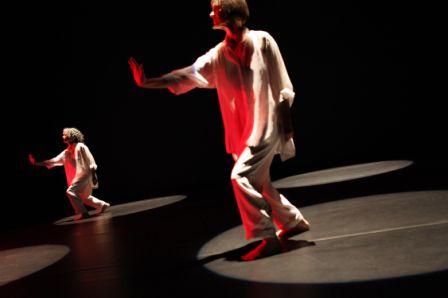
Rudner and Reitz dancing in circles. Photo by Julieta Cervantes.
She still manages beautiful bare-bones effects. The Baryshnikov centre's new Jerome Robbins black box exposes the lights to view, so we watch green filters turn Reitz and Rudner phosphorescent; the blue create splotches on their flowy white outfits, like sun spots on the retina; and the red endow their silhouettes with a hazy outline, as sunset might. There are also Tipton's famously lovely spectrum of yellows - the full range of what "light" brings to mind.
The trouble comes with the shapes - for example, the variously sized circles shined on the floor that serve as dancer obstacle course......
For the whole review, click here.
Maybe I will connect the subjects, in the heading above, later in the week. For now, only have time to post the reviews.
Last day to see the new Ratmansky is Wednesday. Be forewarned: it has a shape all its own, which revealed itself, to me, anyway, only on a second viewing. But if you know from the start that the hour-long work--in itself an odd length for a ballet, neither the usual full-length nor the usual 20 minute plotless--races through its outline in the first half hour, then dallies in divertissements before returning in the last 10 minutes to its story, you will be better off than I was.
First time around I felt both befuddled and enchanted. The second time--which I reviewed, because the first was an exclusive gala--the fog had lifted and only delight, awe, etc remained.
The audience that second time didn't seem to have any trouble loving it from the get-go. I think my experience with 19th century ballet actually hindered me from seeing the whole shape right off, as the Ratmansky is brimming with witty allusions and you can get lost in them.
Here's some of the review, for the Financial Times this past Friday:
Though his subtitle suggests otherwise, Alexei Ratmansky's Namouna, A Grand Divertissement does have a plot: basically the same one as Le Corsaire, The Sleeping Beauty, Raymonda, Sylvia and nearly every other 19th-century ballet. Boy meets girl; boy loses girl; boy finds girl. The difference with Namouna is that boy meets dozens of girls - and can hardly decide between them.
Some of those dozens in their first outfits of the night: Louise Brooks flapper caps and Empire waist sand-yellow accordion-pleated shoulderless gowns. The bathing beauty-ocean sprite get up comes later. Photo by Paul Kolnik for the New York City Ballet.
Despite a shimmering score by Edouard Lalo that Debussy singled out as "a masterpiece among too many stupid ballets", Namouna hasn't been heard from much since it flopped at the Paris Opera in 1882. Ratmansky sets his version for the New York City Ballet on a beach in the Mediterranean in the 1920s. Film director Rustam Khamdamov and NYCB costume director Marc Happel's inspired costumes evoke sand, sea and midnight sky. Our hero, Robert Fairchild in a little boy's sailor suit, resembles Lewis Carroll's Alice - plopped down in a world that goes about its strange business with outrageous self-assurance. Ratmansky's wonderland is the spectacle of imperial ballet itself.
Our docile hero's quest is a bit vague. He is just looking. Two dozen bathing beauties in jellyfish tutus and conch-shell bathing caps look right back. Together with two Carmens - Jenifer Ringer smoking while dancing as Sara Mearns devours space and men's affections - the corps wants him. And yet they only know each other, bickering and making up dances out of what they glimpse from the sidelines. The poignancy of their position - one boy and all these girls - leaps off the stage and into your heart. It's as if Hamlet co-starred the gravediggers.....
For the whole review, click here.
The All-Balanchine program this year was a great triad, presented chronologically so you could feel the evolution of the choreographer's thinking--or one thread of it, anyway: Concerto Barocco, The Four Temperaments, and Symphony in Three Movements. I'm not sure the last, the 1972 Stravinsky ballet, benefits from comparison to The Four Ts.
At this point, the ballets are appearing individually, on mixed programs. Through May 22. Here's some of my review from last week:
People like to say great art is timeless. But the three plotless pieces by Balanchine that opened New York City Ballet's spring season on Sunday not only transcend their moment, they reflect on it.Concerto Barocco, which premiered in 1941, began as an exercise for Balanchine's students. He must have been instructing them in the ballet ethos of graciousness. The dance begins with an ancient step: the bow with which a courtier greeted the king, inclining toward his outstretched leg as if to offer his exposed calf as a gift.
Concerto Barocco rings variations on this theme of reverence, with a small female corps lunging deeply - heads lowered - before the reigning dancers, or interlacing their arms as if to provide a net for the queen ballerina's landings from scalloping leaps. At one point, the women twirl slowly upstage, arms in a V. They seem to be floating not in space but in the imagination.
Concert Barocco. Photo by Paul Kolnik for New York City Ballet.
Balanchine always honoured the ballet virtues of grace and graciousness, but he never again paid such obsessive tribute. Five years on, he is diving flexed-foot first into the dislocations of modernism. In place of action and deferential response, The Four Temperaments offers action and retraction, push and pull, entanglement and entrapment. A ship's figurehead replaces the courtly bow, with the woman's pelvis the prow that plows through troubled waters. To the leisurely menace of Paul Hindemith's score, the ballet conjures the psychological mood of a Hitchcock thriller even as the dancers perform their contortions with cool impassivity.
By 1972, when he created Symphony in Three Movements, Balanchine had given his modernism a mannerist twist, making sport of....
For the whole review, click here. (If they ask you to register, you only have to do so once and then you get 30 articles a month. And it's free.)
I have always admired choreographer Stephen Petronio, but also have had certain reticences here and there: that the sophisticated bad-boy tone held the choreography back or that Petronio didn't take sufficient advantage of his strong musical propensities. This past Tuesday, however, I was awed: one of those happy experiences where you come out of the theater recognizing with alarm how absorbed you were.
It wasn't just that the dances were particularly strong, it was how they worked together, so that with each new work you understood the last one and the present one better: a burrowing deeper. "Smartly curated" is my shorthand for that more-than-the-sum-of-its-parts experience.
The day after I filed my review, the esteemed New York Times critic Roslyn Sulcas's review came out; I think she had a similar experience. Choreographers are often disappointed that writers don't much praise a work that moves them while they are sure to apply every pejorative in the book when it doesn't. But these are not symmetrical experiences--not for the writer. When you are moved, you don't simply want to say it is great, mesmerizing, wondrous, marvelous, etc., etc., you are on a mission to figure out why. When you aren't moved, you are far enough outside the experience to resort to potted negatives.
Anyway, here's my review, published Thursday, for the Financial Times:
For the 11-member ensemble's 1990 signature piece MiddleSexGorge, the men don corsets over bare bottoms. This unlikely coupling of restraint and outrageousness typifies the choreography as well. Dagger-like limbs punctuate roiling torsos and rolling hips. Plunging pliés fraternise with stork-like balances. Strident awkwardness makes peace with ribbony grace. Formalism works in the service of chaos.The five dances on this year's smartly curated programme - two premieres and three repertory works from the 25-year-old company's first decade - include solos as short as a pop song and ensemble works five times as long, pieces in an ironic romantic mode and pieces as impersonally theatrical as the weather. Over the course of this prismatic evening, the choreography grows more beautiful - and mysterious.
The evening begins with Petronio spotlit and alone on stage. In the 1986 solo #3, his arms seem to be squeezing his torso into place, as if without the contortions of his creaturely arms it would ooze on to the floor. In this rare cameo, the 54-year-old dancer is both luscious in body and precise in tortured limbs.
At one point he impersonates Balanchine in that famous photograph of him demonstrating the proper way to do a tendu, an essential ballet step. Petronio is preparing us for his deformations of classical pieties. In the group pieces MiddleSexGorge and the not yet fully realised Ghostown, legs don't point skyward, they slash sideways like a sword. Instead of pas de deux, we get trios, with one dancer suspended crucifixion-style between the other two, restrained as much as supported. And the spatial harmonies in the several clusters of dancers doing different things at the same time, as in Cunningham, are only clear enough to make the threat of anarchy more tangible and thrilling.
More than classicism, however, Petronio rebels against the anti-pop orthodoxy of much postmodern dance.....
For the whole review, click here.
The Petronio company performs at the Joyce through Sunday, May 2.
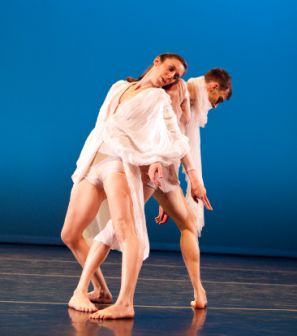
Mandy Kirschner and Australian guest artist Reed Luplau. Kirschner, a former Cunningham dancer who brings to the Petronio work that Merceian clarity, joins a few other incredible women in the current troupe: Shila Tirabassi, Amanda Wells, and Tara Lorenzen. The men and other women are promising, but they haven't quite figured out the drama in Petronio's style; they tend to efface themselves more than necessary. Photo by Yi-Chun Wu.
AJ Blogs
AJBlogCentral | rssculture
Terry Teachout on the arts in New York City
Andrew Taylor on the business of arts & culture
rock culture approximately
Laura Collins-Hughes on arts, culture and coverage
Richard Kessler on arts education
Douglas McLennan's blog
Dalouge Smith advocates for the Arts
Art from the American Outback
Chloe Veltman on how culture will save the world
For immediate release: the arts are marketable
No genre is the new genre
David Jays on theatre and dance
Paul Levy measures the Angles
Judith H. Dobrzynski on Culture
John Rockwell on the arts
innovations and impediments in not-for-profit arts
Jan Herman - arts, media & culture with 'tude
dance
Apollinaire Scherr talks about dance
Tobi Tobias on dance et al...
jazz
Howard Mandel's freelance Urban Improvisation
Focus on New Orleans. Jazz and Other Sounds
Doug Ramsey on Jazz and other matters...
media
Jeff Weinstein's Cultural Mixology
Martha Bayles on Film...
classical music
Fresh ideas on building arts communities
Greg Sandow performs a book-in-progress
Harvey Sachs on music, and various digressions
Bruce Brubaker on all things Piano
Kyle Gann on music after the fact
Greg Sandow on the future of Classical Music
Norman Lebrecht on Shifting Sound Worlds
Joe Horowitz on music
publishing
Jerome Weeks on Books
Scott McLemee on books, ideas & trash-culture ephemera
theatre
Wendy Rosenfield: covering drama, onstage and off
visual
Public Art, Public Space
Regina Hackett takes her Art To Go
John Perreault's art diary
Lee Rosenbaum's Cultural Commentary
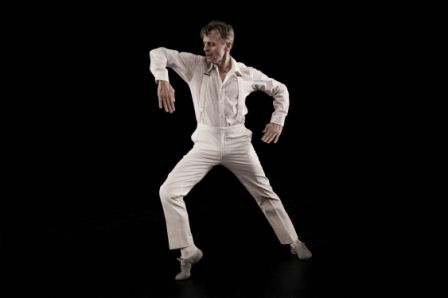
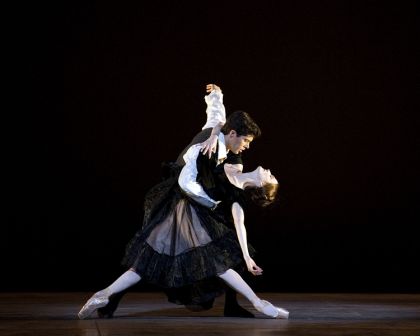
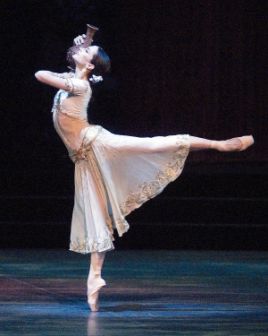
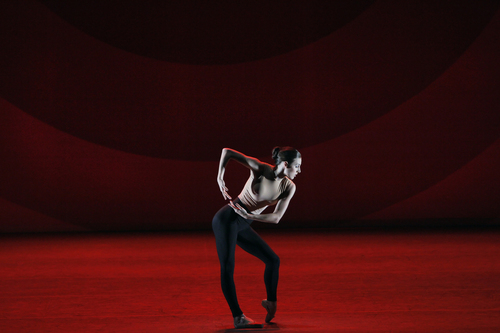
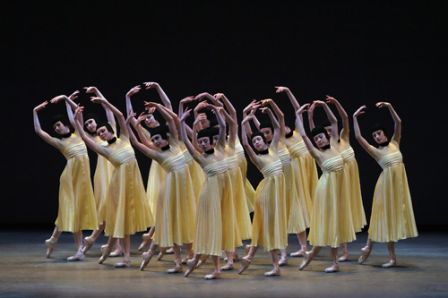
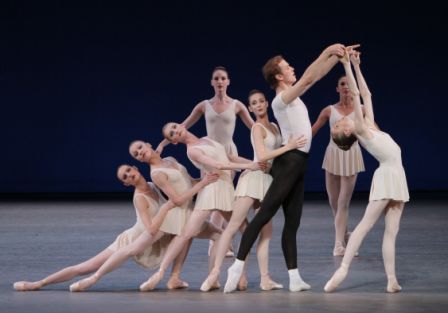

Recent Comments